|
CHAPTER III.
The Common Frog | ||
3. CHAPTER III.
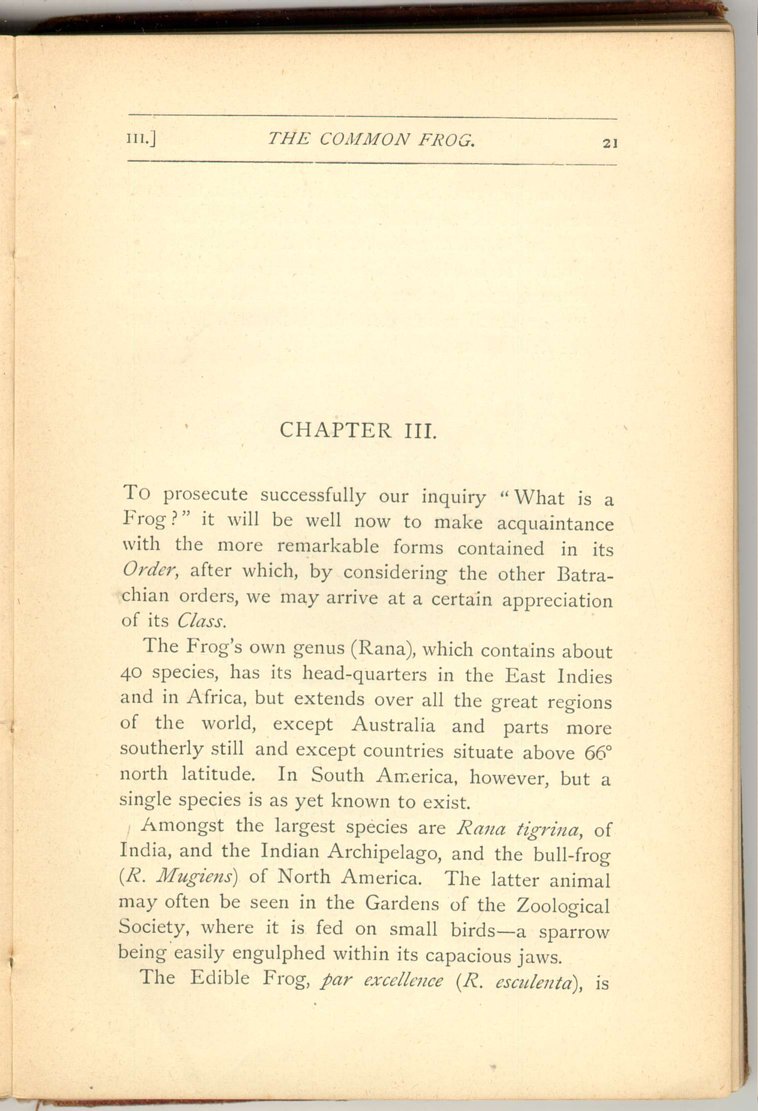 [Description:
Image of page 21.
]
[Description:
Image of page 21.
]
To prosecute successfully
our inquiry "What is a Frog?" it will be well now
to make acquaintance with the more remarkable forms
contained in its Order, after which, by
considering the other Batrachian orders, we may
arrive at a certain appreciation of its Class.
The Frog's own genus (Rana), which contains about 40 species, has its head-quarters in the East Indies and in Africa, but extends over all the great regions of the world, except Australia and parts more southerly still and except countries situate above 66 ° north latitude. In South America, however, but a single species is as yet known to exist.
Amongst the largest species are Rana tigrina, of India, and the Indian Archipelago, and the bull-frog ( R. Mugiens) of North America. The latter animal may often be seen in the Gardens of the Zoological Society, where it is fed on small birds—a sparrow being easily engulphed within its capacious jaws.
The Edible Frog, par excellence (R. esculenta), is
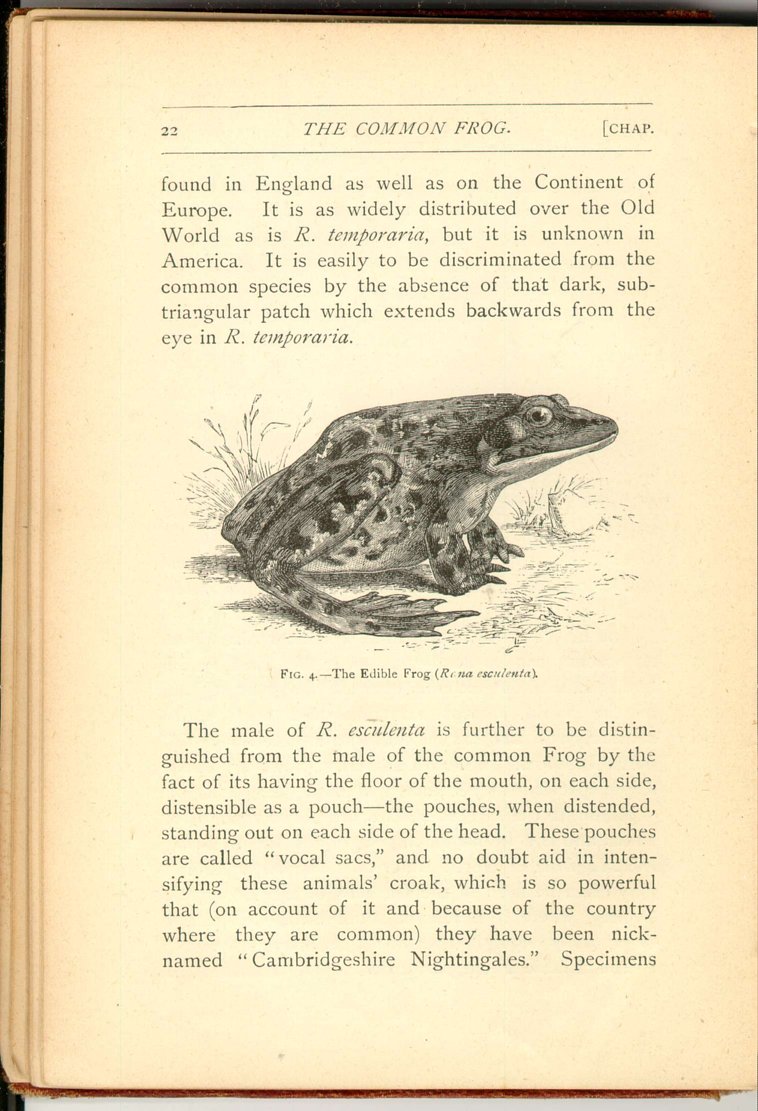 [Description:
Image of page 22.
]
[Description:
Image of page 22.
]
The male of R. esculenta is further to be distinguished from the male of the common Frog by the fact of its having the floor of the mouth, on each side, distensible as a pouch—the pouches, when distended, standing out on each side of the head. These pouches are called "vocal sacs," and no doubt aid in intensifying these animals' croak, which is so powerful that (on account of it and because of the country where they are common) they have been nicknamed "Cambridgeshire Nightingales." Specimens
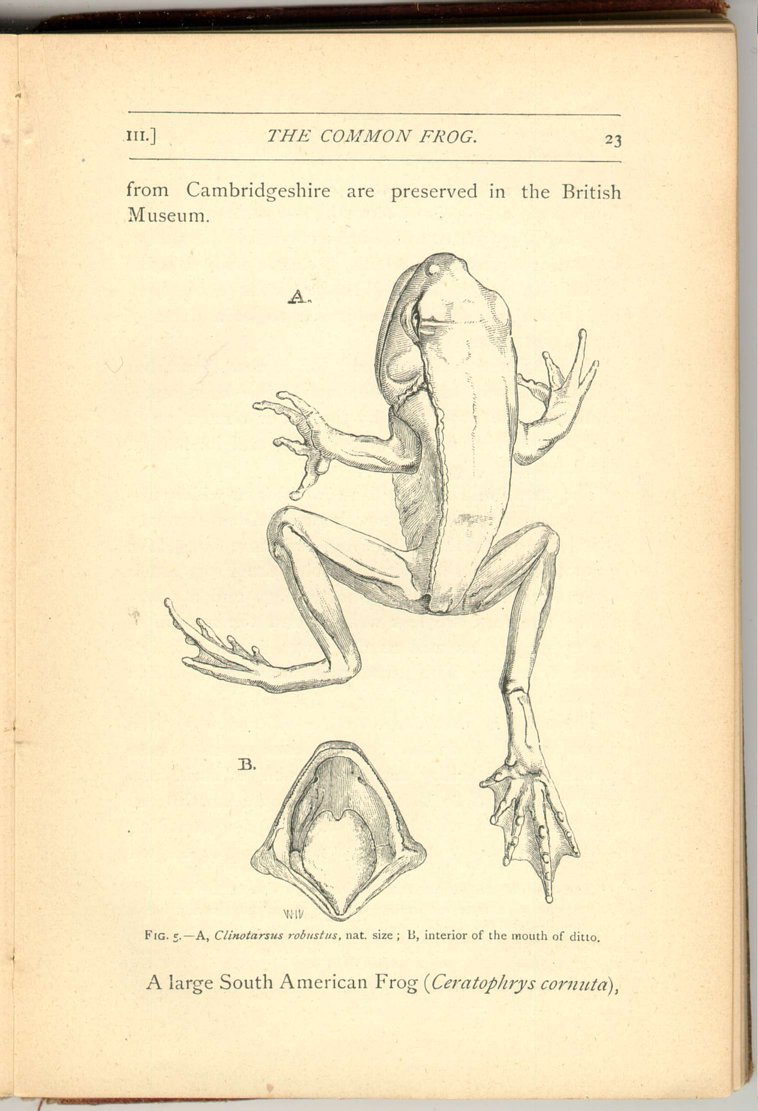 [Description:
Image of page 23.
]
[Description:
Image of page 23.
]
A large South American Frog ( Ceratophrys cornuta),
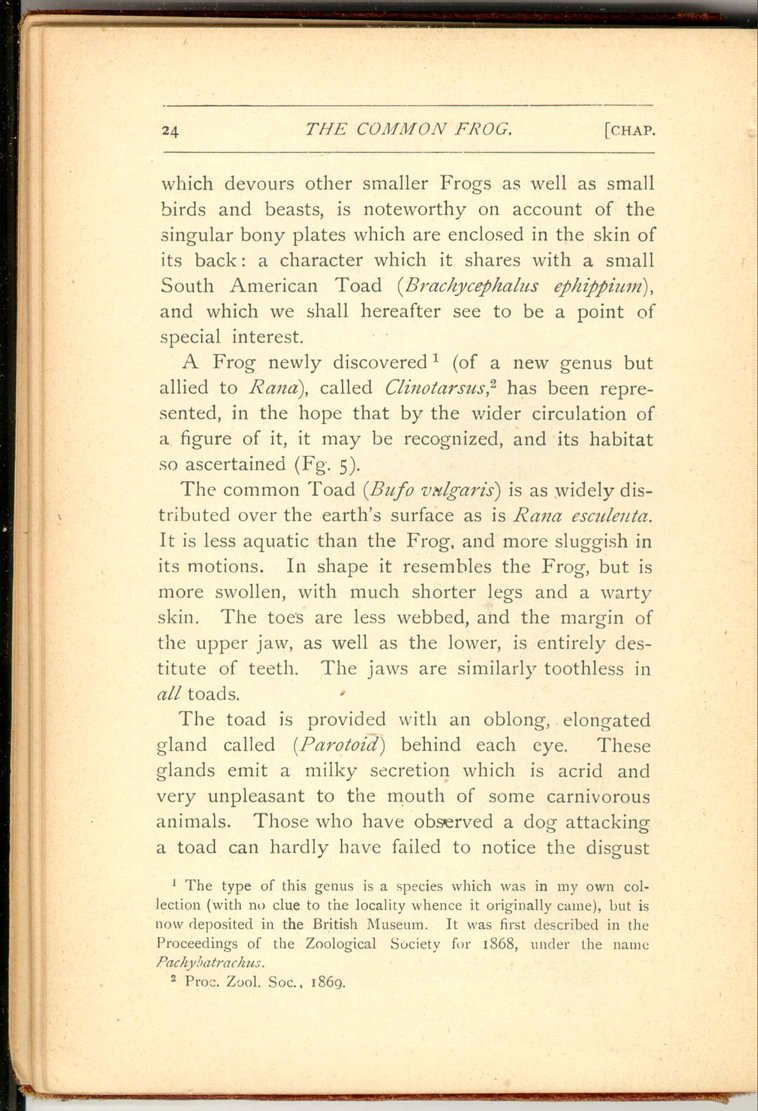 [Description:
Image of page 24.
]
[Description:
Image of page 24.
]
A Frog newly discovered [8] (of a new genus but allied to Rana), called Clinotarsus, [9] has been represented, in the hope that by the wider circulation of a figure of it, it may be recognized, and its habitat so ascertained (Fg. 5).
The common Toad (Bufo vulgaris) is as widely distributed over the earth's surface as is Rana esculenta. It is less aquatic than the Frog, and more sluggish in its motions. In shape it resembles the Frog, but is more swollen, with much shorter legs and a warty skin. The toes are less webbed, and the margin of the upper jaw, as well as the lower, is entirely destitute of teeth. The jaws are similarly toothless in all toads.
The toad is provided with an oblong, elongated gland called (Parotoid) behind each eye. These glands emit a milky secretion which is acrid and very unpleasant to the mouth of some carnivorous animals. Those who have observed a dog attacking a toad can hardly have failed to notice the disgust
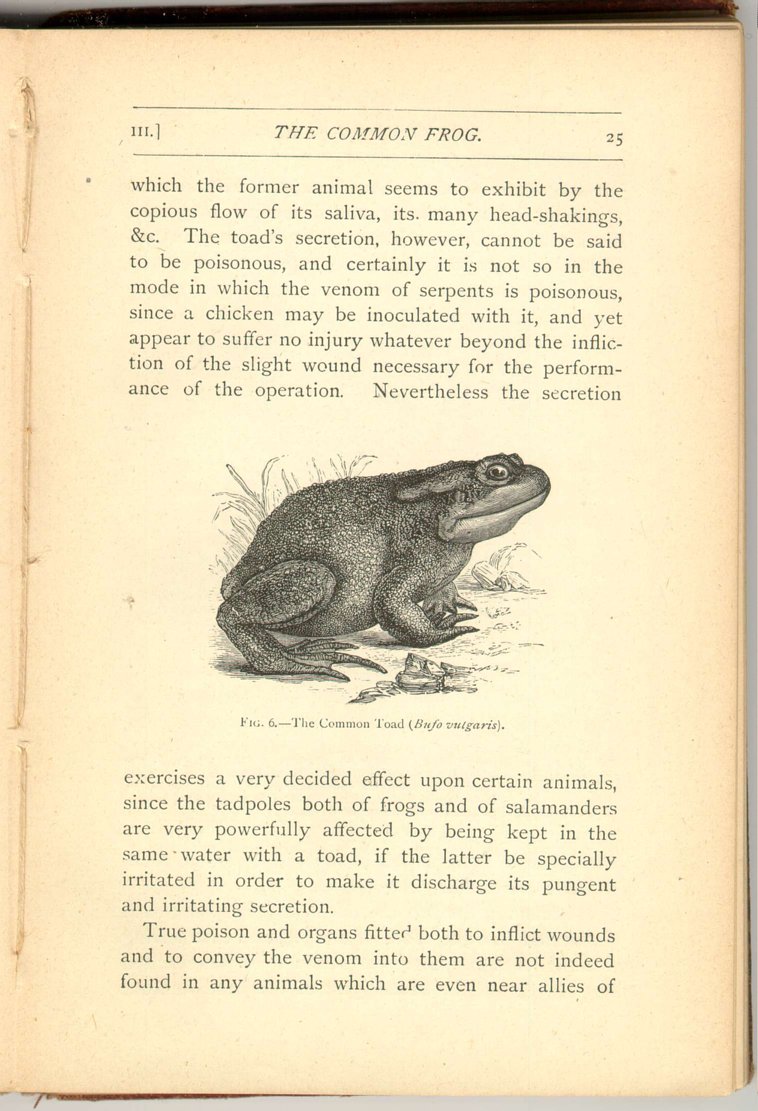 [Description:
Image of page 25.
]
[Description:
Image of page 25.
]
True poison and organs fitted both to inflict wounds and to convey the venom into them are not indeed found in any animals which are even near allies of
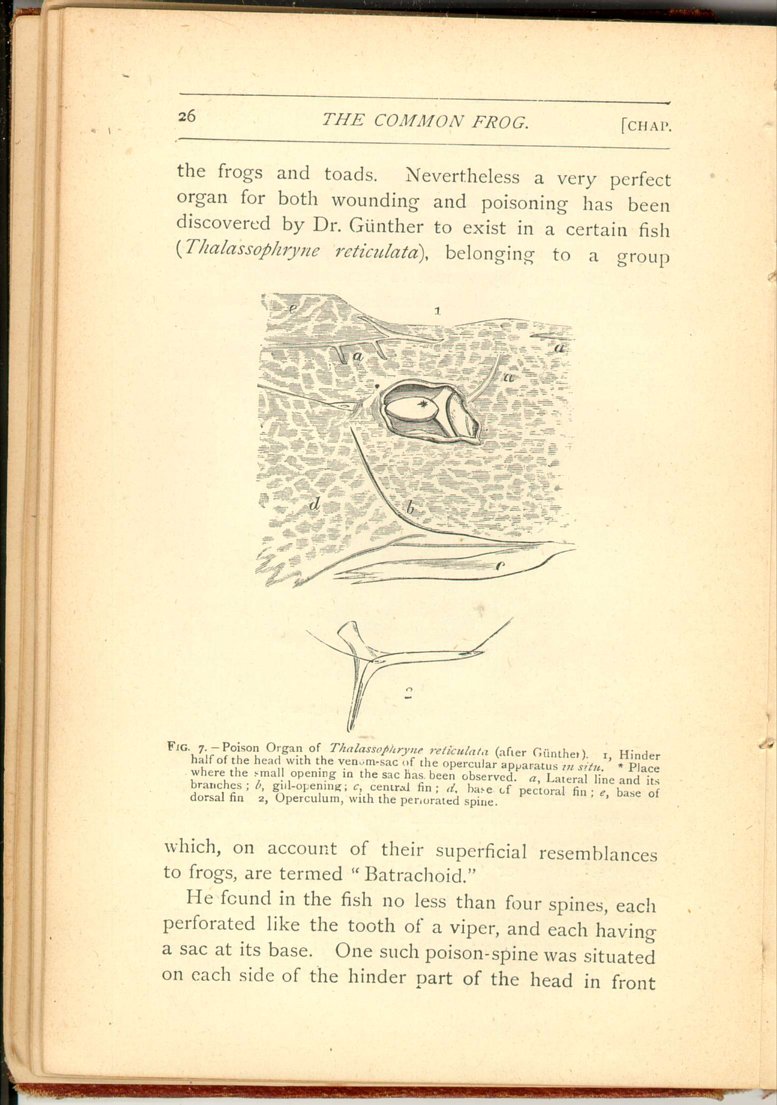 [Description:
Image of page 26.
]
[Description:
Image of page 26.
]
He found in the fish no less than four spines, each perforated like the tooth of a viper, and each having a sac at its base. One such poison-spine was situated on each side of the hinder part of the head in front
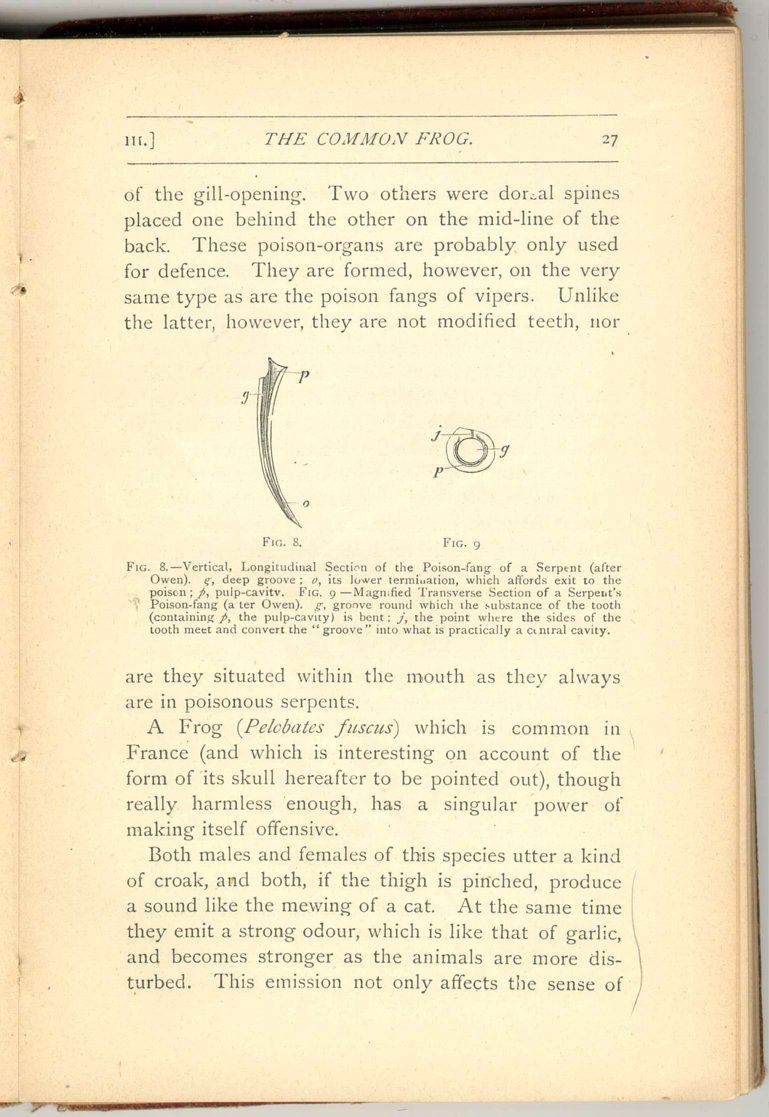 [Description:
Image of page 27.
]
[Description:
Image of page 27.
]
A Frog (Pelobates fuscus) which is common in France (and which is interesting on account of the form of its skull hereafter to be pointed out), though really harmless enough, has a singular power of making itself offensive.
Both males and females of this species utter a kind of croak, and both, if the thigh is pinched, produce a sound like the mewing of a cat. At the same time they emit a strong odour, which is like that of garlic, and becomes stronger as the animals are more disturbed. This emission not only affects the sense of
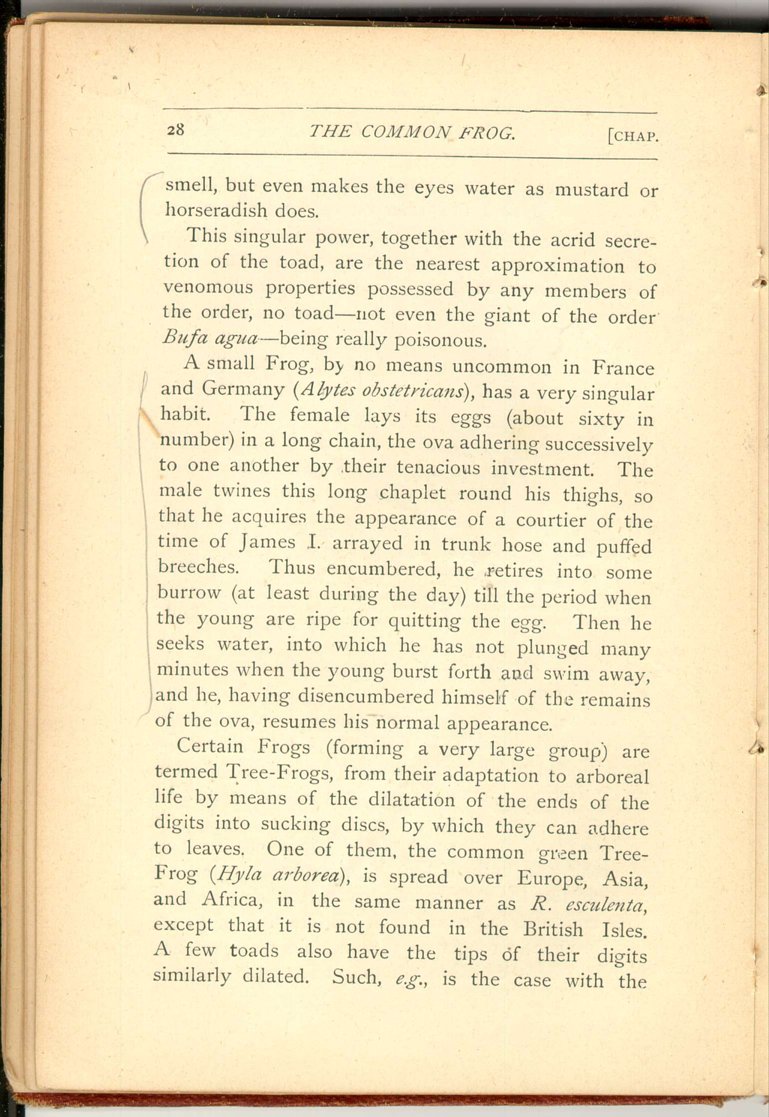 [Description:
Image of page 28.
]
[Description:
Image of page 28.
]
This singular power, together with the acrid secretion of the toad, are the nearest approximation to venomous properties possessed by any members of the order, no toad—not even the giant of the order Bufa agua—being really poisonous.
A small Frog, by no means uncommon in France and Germany (Alytes obstetricans), has a very singular habit. The female lays its eggs (about sixty in number) in a long chain, the ova adhering successively to one another by their tenacious investment. The male twines this long chaplet round his thighs, so that he acquires the appearance of a courtier of the time of James I. arrayed in trunk hose and puffed breeches. Thus encumbered, he retires into some burrow (at least during the day) till the period when the young are ripe for quitting the egg. Then he seeks water, into which he has not plunged many minutes when the young burst forth and swim away, and he, having disencumbered himself of the remains of the ova, resumes his normal appearance.
Certain Frogs (forming a very large group) are termed Tree-Frogs, from their adaptation to arboreal life by means of the dilatation of the ends of the digits into sucking discs, by which they can adhere to leaves. One of them, the common green Tree-Frog (Hyla arborea), is spread over Europe, Asia, and Africa, in the same manner as R. esculenta except that it is not found in the British Isles. A few toads also have the tips 6f their digits similarly dilated. Such, e.g., is the case with the
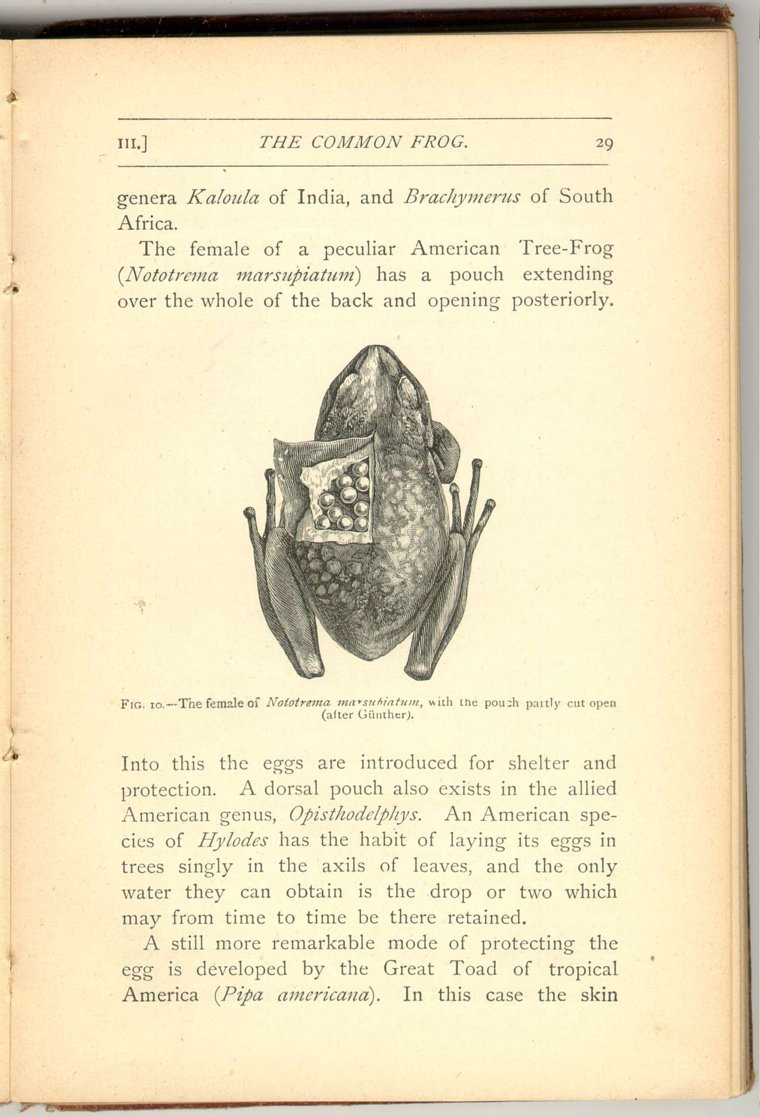 [Description:
Image of page 29.
]
[Description:
Image of page 29.
]
The female of a peculiar American Tree-Frog ( Nototrema marsupiatum) has a pouch extending over the whole of the back and opening posteriorly.
A still more remarkable mode of protecting the egg is developed by the Great Toad of tropical America (Pipa americana). In this case the skin
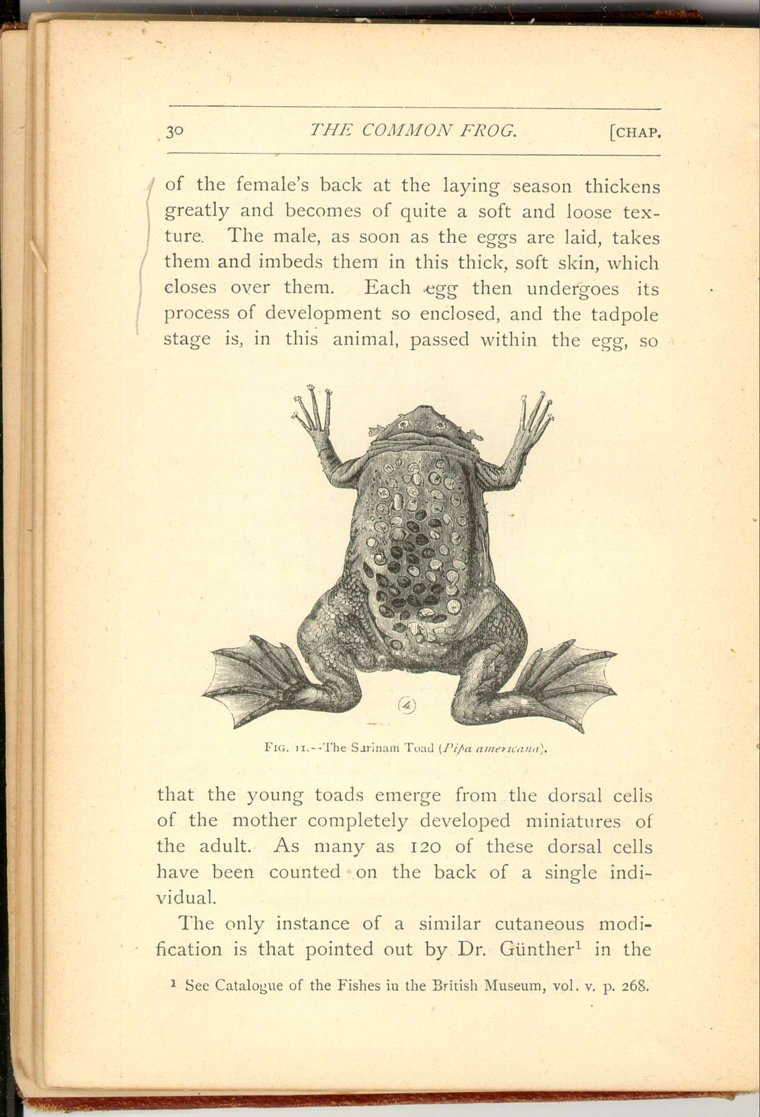 [Description:
Image of page 30.
]
[Description:
Image of page 30.
]
The only instance of a similar cutaneous modification is that pointed out by Dr. Günther [10] in the
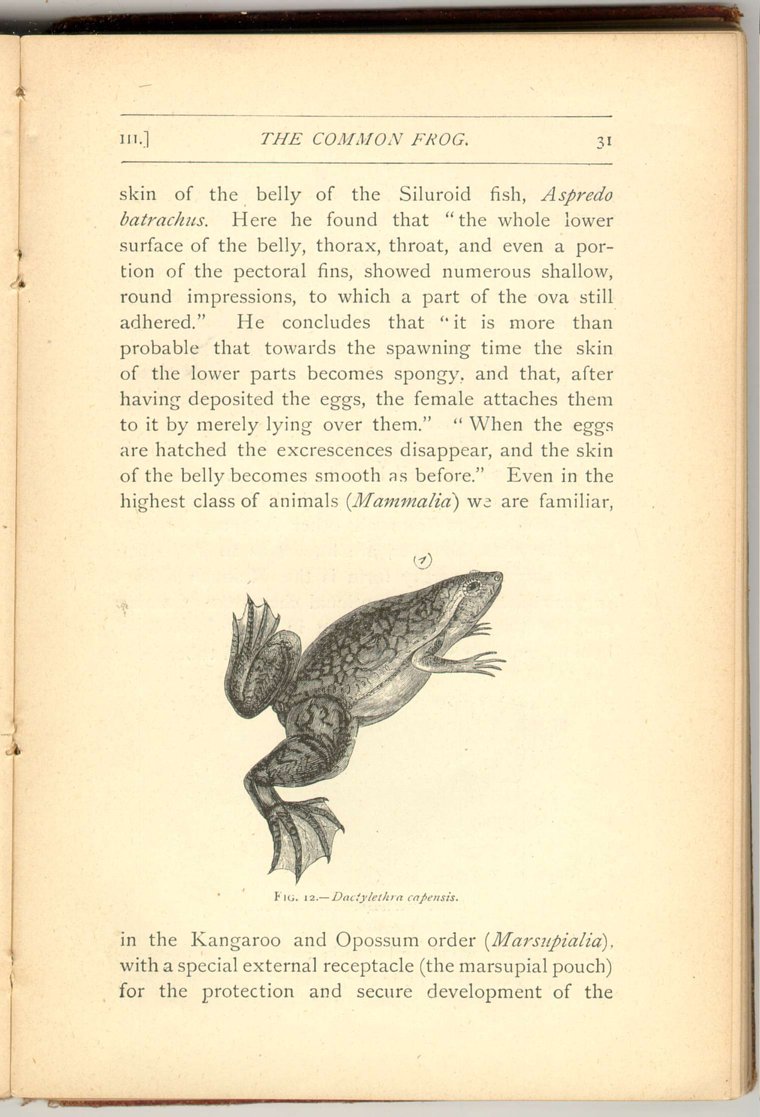 [Description:
Image of page 31.
]
[Description:
Image of page 31.
]
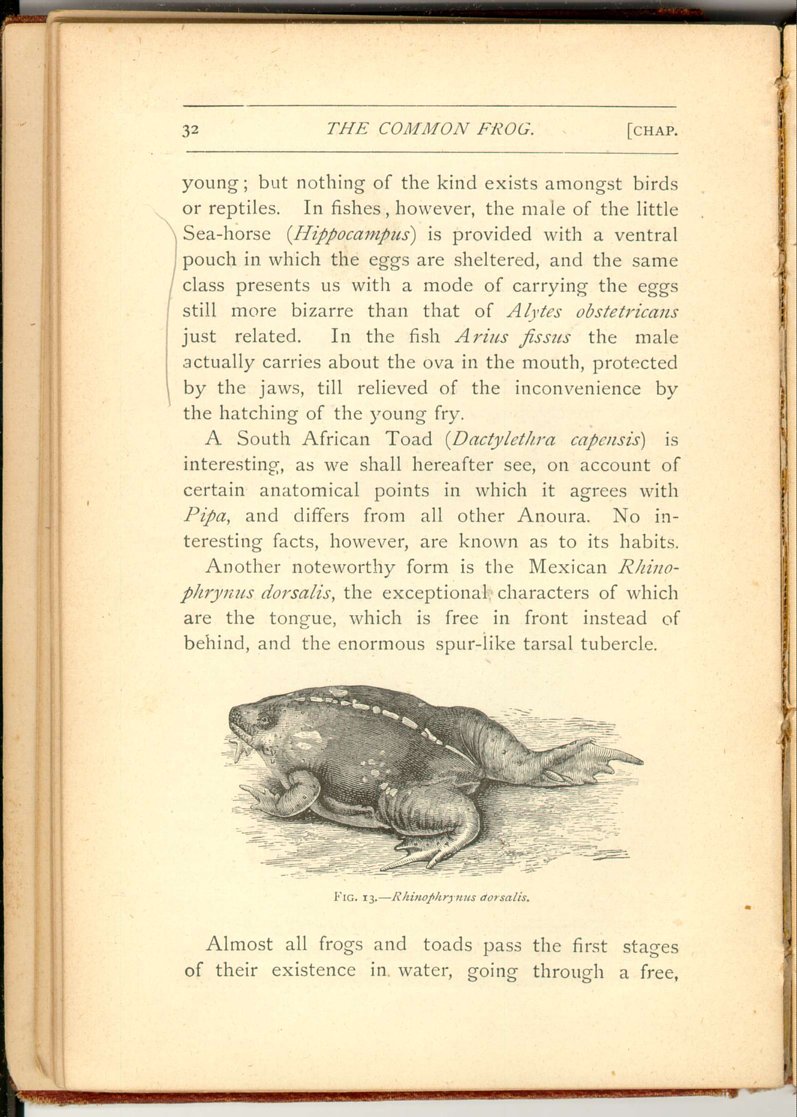 [Description:
Image of page 32.
]
[Description:
Image of page 32.
]
A South African Toad ( Dactylethra capensis) is interesting, as we shall hereafter see, on account of certain anatomical points in which it agrees with Pipa, and differs from all other Anoura. No interesting facts, however, are known as to its habits.
Another noteworthy form is the Mexican Rhinophrynus dorsalis, the exceptional characters of which are the tongue, which is free in front instead of behind, and the enormous Spur-like tarsal tubercle.
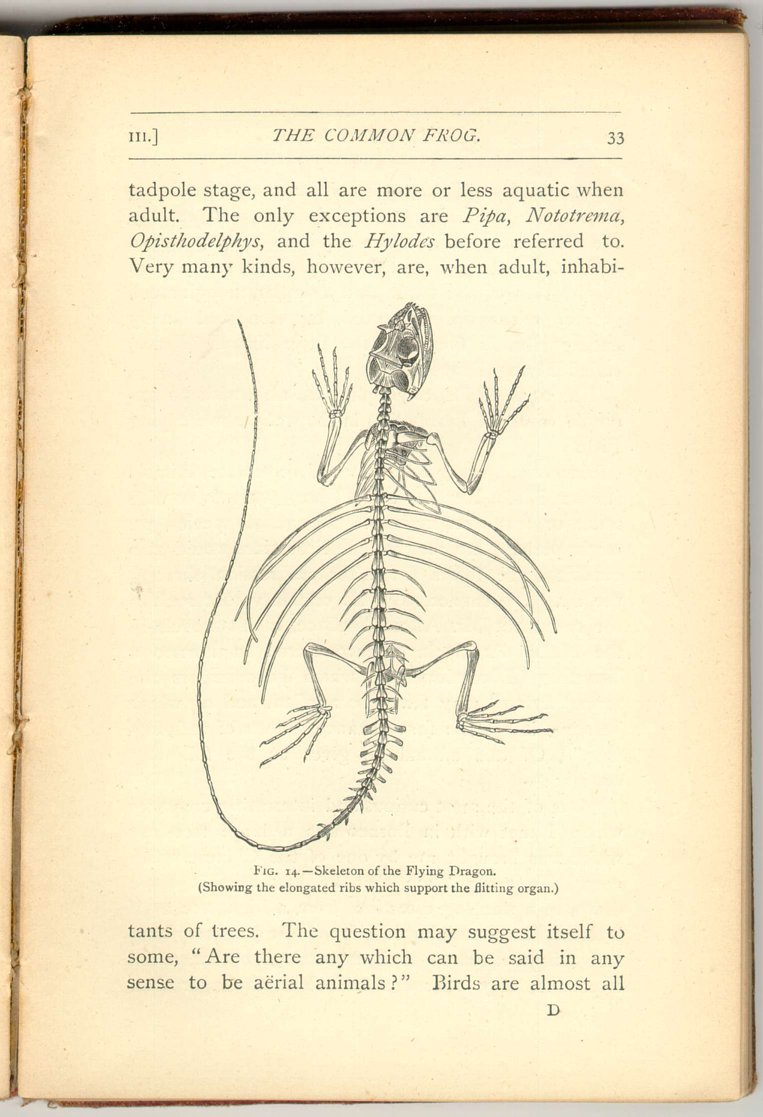 [Description:
Image of page 33.
]
[Description:
Image of page 33.
]
(Showing the elongated ribs which support the flitting organ.)
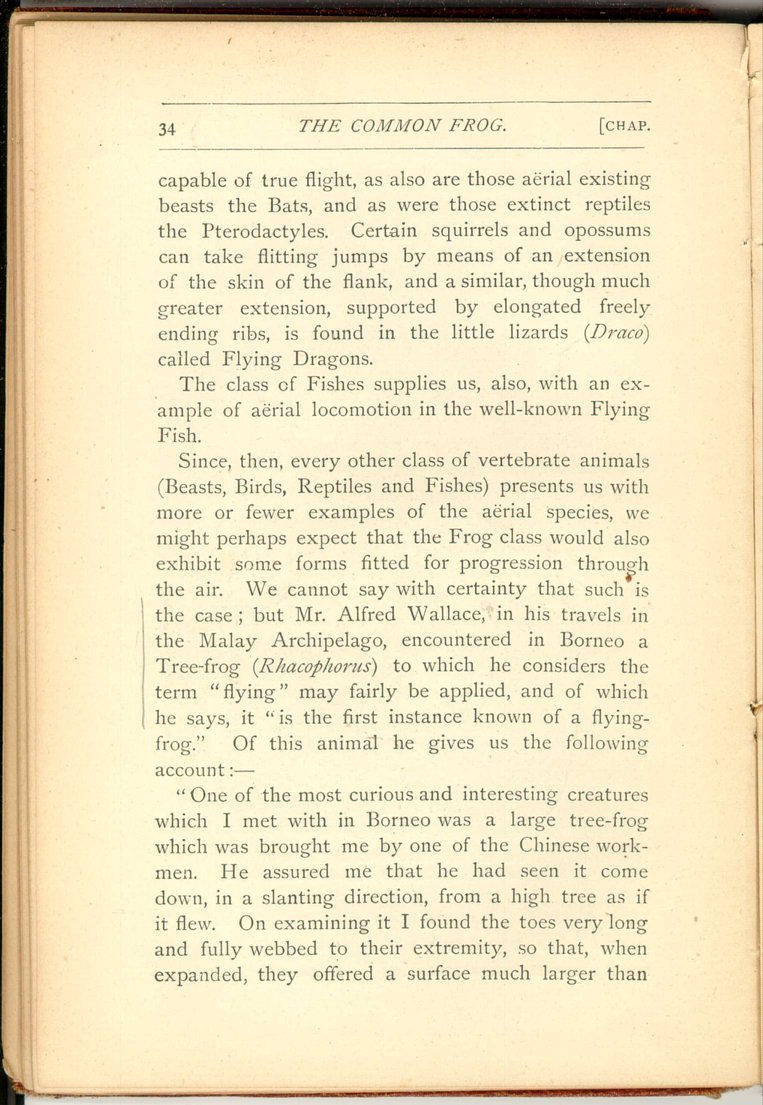 [Description:
Image of page 34.
]
[Description:
Image of page 34.
]
The class of Fishes supplies us, also, with an example of aërial locomotion in the well-known Flying Fish.
Since, then, every other class of vertebrate animals (Beasts, Birds, Reptiles and Fishes) presents us with more or fewer examples of the aërial species, we might perhaps expect that the Frog class would also exhibit some forms fitted for progression through the air. We cannot say with certainty that such is the case; but Mr. Alfred Wallace, in his travels in the Malay Archipelago, encountered in Borneo a Tree-frog (Rhacophorus) to which he considers the term "flying" may fairly be applied, and of which he says, it "is the first instance known of a flying frog." Of this animal he gives us the following account:—
"One of the most curious and interesting creatures which I met with in Borneo was a large tree-frog which was brought me by one of the Chinese workmen. He assured me that he had seen it come down, in a slanting direction, from a high tree as if it flew. On examining it I found the toes very long and fully webbed to their extremity, so that, when expanded, they offered a surface much larger than
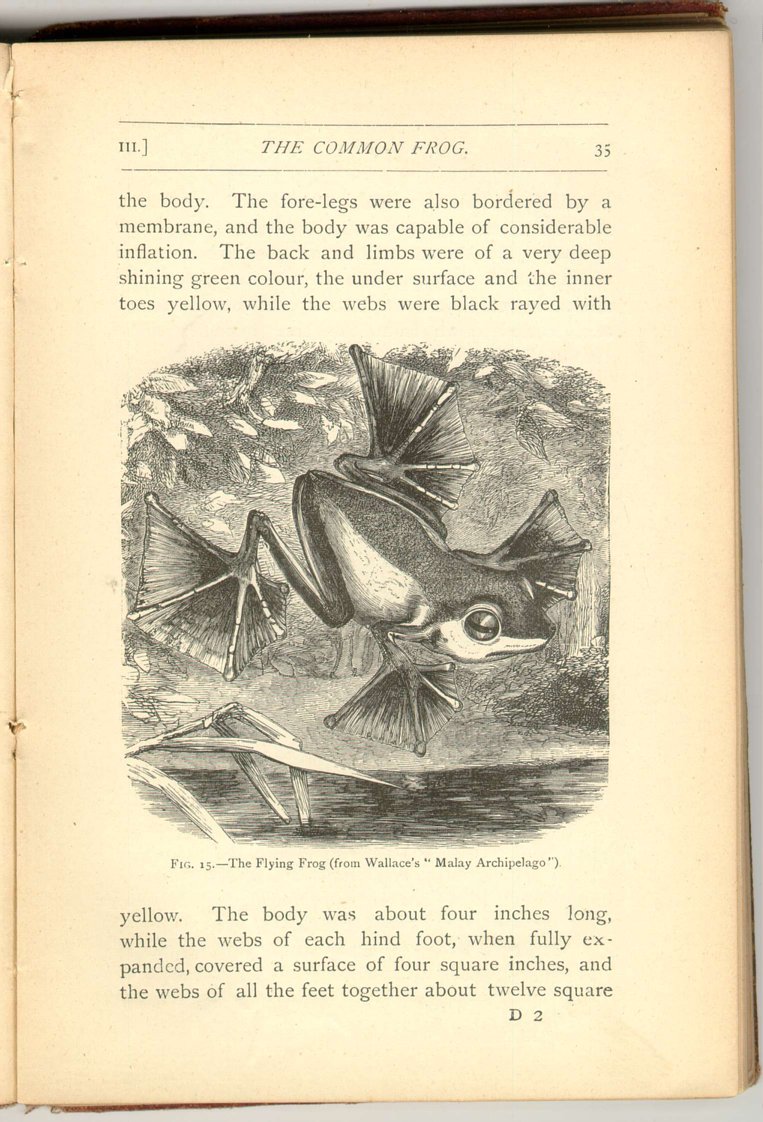 [Description:
Image of page 35.
]
[Description:
Image of page 35.
]
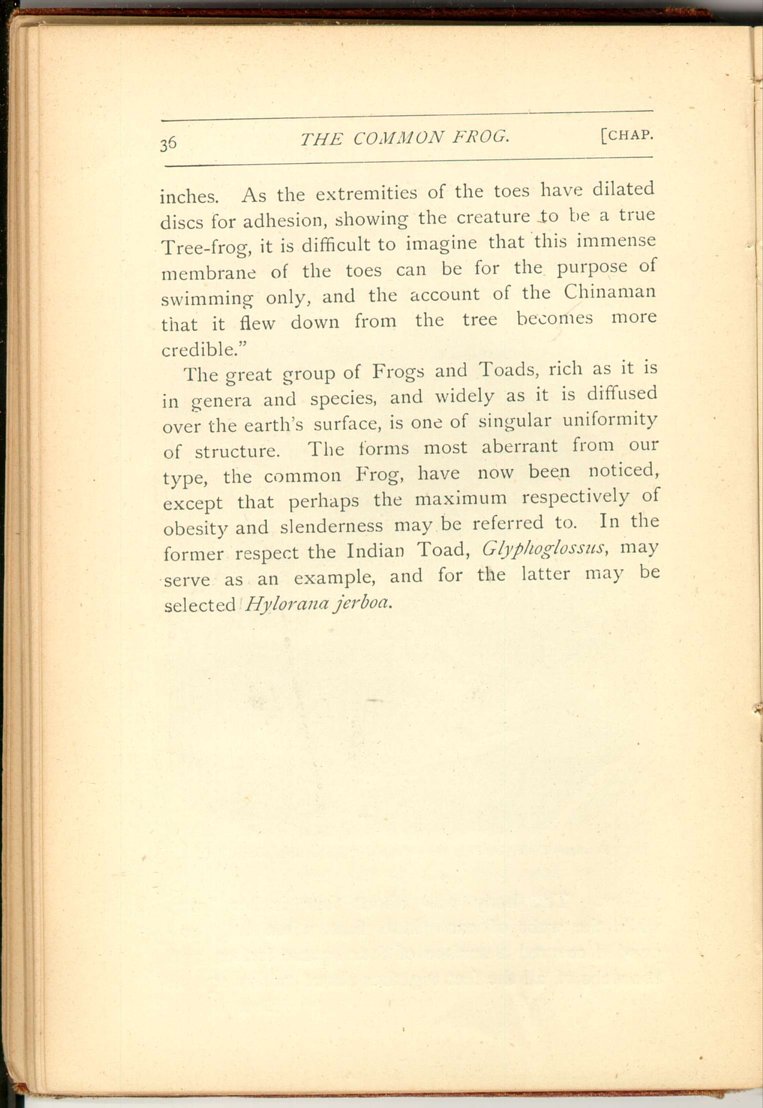 [Description:
Image of page 36.
]
[Description:
Image of page 36.
]
The great group of Frogs and Toads, rich as it is in genera and species, and widely as it is diffused over the earth's surface, is one of singular uniformity of structure. The forms most aberrant from our type, the common Frog, have now been noticed, except that perhaps the maximum respectively of obesity and slenderness may be referred to. In the former respect the Indian Toad, Glyphoglossus, may serve as an example, and for the latter may be selected Hylorana jerboa.
FOOTNOTES: Chapter 3
|
CHAPTER III.
The Common Frog | ||